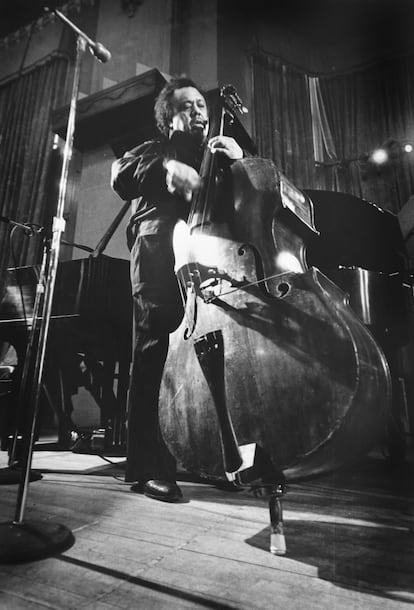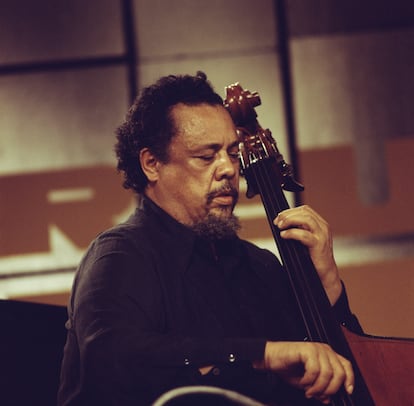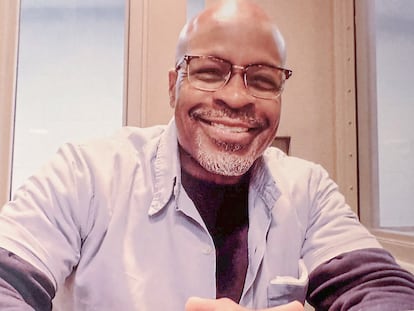Charles Mingus: 100 years of jazz’s great volcano
This year marks a century since the birth of the immense composer. A boxset of his 1970s recordings will commemorate the anniversary

The grandiose spectacle of a volcano of emotions. Listening to the music of Charles Mingus, one of the greatest jazz musicians of all time, is like contemplating a volcano in all its majesty. At times, that big man with a piercing gaze, stony face and wild hair, with a cigar in his mouth billowing smoke, transmits a magnetic calm, capable of hiding indecipherable mystery. At other moments that mountain, operating with impressive tension, appears to be about to explode. And at so many other junctures, the phenomenon of nature mercilessly explodes in a blowout of lava, gas and ash, a musical eruption that very few could achieve. One way or another, the impetuous Mingus, the double bass player, pianist, composer and orchestra conductor, always looked to push the limits.
A century has passed since the birth of the musician, who died at the age of 56 in 1979. Above all, he stood out as an immense composer. He achieved recognition in the most erudite of circles, but it should be noted that Mingus does not enjoy the same popularity of other jazz giants, such as his much-admired Charlie Parker, Miles Davis, John Coltrane, Louis Armstrong or Duke Ellington, one of his earliest and most decisive influences.
Although Mingus was feted by both colleagues and critics, history books have not been fair to his legacy, his passionate, beautiful, rich work that pulls from the legacy of Black music to break free from white indoctrination, a constant struggle against the conventions and commercialization of art. In spite of it all, his name should be included alongside the greatest composers in the history of United States popular music as an insatiable and groundbreaking creator who, driven by an authentic heart and privileged head, broadened horizons and remained true to himself until the end. This can be appreciated in the last record release under his name, which is one of the most outstanding of this soon-to-expire 2023.

To commemorate these 100 years since his birth, Warner Music has reissued a lustrous boxset in vinyl and CD formats. Changes: the Complete 1970s Atlantic Recordings includes all of his albums published during that decade by Atlantic Recordings when, disappointed by his time at Impulse!, where he made such masterpieces as The Black Saint and the Sinner Lady (1963) and Mingus, Mingus, Mingus, Mingus, Mingus (1964), Mingus returned to Atlantic, one of the labels at which, with works as sublime as Pithecanthropus Erectus (1954) and Blues & Roots (1959), he cultivated an image as an enfant terrible of the ‘50s, the golden age of bebop, a passionate artist of controversies and rivalries.
It is both overwhelming and captivating to delve into a career as great that of this being, possessor of such voracious artistic hunger. Even more so to think of how Mingus died at a relatively young age: 56 years old, a victim of ALS who was at the time searching for alternative treatment for the disease in Mexico. From the boxset of his last years at Atlantic come the last two albums released after his death, My, Myself an Eye and Something Like a Bird, whose recording sessions he attended in a wheelchair and whose music was mainly intended for a collaboration with Joni Mitchell. That was Mingus, an indomitable beast who always looked and found.
The final phase of his career, whose seven albums between 1973 and 1979 the boxset collects, is full of discoveries. There’s Cumbia & Jazz (1977), in which calypso mixes with hard-bop and gospel. He had a conservatory education in classical fundamentals, the starting point of his career back when his main instrument was the trombone. But he used to say that his music came from the church. Truth be told, it had always had that spiritual and archaic drive, celebratory of the African-American community, but he elevated the sound with his great knowledge of jazz and European classical music. He could speak just as easily of Bach and Debussy as Freddie Webster or Art Tatum.
The most impressive findings in the boxset are albums Mingus Moves (1973), Changes One (1973) and Changes Two (1974). They are three very different works that, due to their instrumental textures, abrasive tonalities and vibrant emotional registers, would be a milestone for any top-notch jazz musician today. A controversial player who never left anyone indifferent to his work, Mingus came into the world in a small town in Arizona, though he would grow up in Watts, one of the most troubled neighborhoods in Los Angeles. His biography is that of a self-made man, a story well-told in his memoir Beneath the Underdog.
Originally published in 1971 and written in the third person, the book does not go about the business of autobiography as usual, choosing instead to tell the story of battles won and lost by “poor boy Mingus,” leaving out musical anecdotes and artistic achievements to delve into the psychology of a survival. Mingus became a neighborhood pimp working with prostitutes and at one point with music to work at the post office, a job that he enjoyed, and one that did not require him to fight the injustices of a record business he was forever calling out. “Jazz is not a profession. It is pure extortion,” he said. The book’s numerous passages on underworld and sexual experiences share space with descriptions of his father’s abuse and racial persecution. Mingus’ Black skin was the focus of problems not only with whites, but also in the ghetto, where some considered him too light due to his Chinese and British heritage.
Beneath the Underdog requires the reader to let go of preconceived notions regarding its author, as he himself did with his music. Mingus, who ended up tired and disillusioned with the music business, and who was not an admirer of free jazz, and was forever fearless and tirelessly independent. The artist could soothe and seduce then, moments later, shake you up and slap you around. His was an unpredictable rhythm. “Art only represents the life of an individual,” he said in a 1971 interview. This individual was a force of nature who represented a one-of-a-kind spectacle: a jazz volcano.
Sign up for our weekly newsletter to get more English-language news coverage from EL PAÍS USA Edition
Tu suscripción se está usando en otro dispositivo
¿Quieres añadir otro usuario a tu suscripción?
Si continúas leyendo en este dispositivo, no se podrá leer en el otro.
FlechaTu suscripción se está usando en otro dispositivo y solo puedes acceder a EL PAÍS desde un dispositivo a la vez.
Si quieres compartir tu cuenta, cambia tu suscripción a la modalidad Premium, así podrás añadir otro usuario. Cada uno accederá con su propia cuenta de email, lo que os permitirá personalizar vuestra experiencia en EL PAÍS.
¿Tienes una suscripción de empresa? Accede aquí para contratar más cuentas.
En el caso de no saber quién está usando tu cuenta, te recomendamos cambiar tu contraseña aquí.
Si decides continuar compartiendo tu cuenta, este mensaje se mostrará en tu dispositivo y en el de la otra persona que está usando tu cuenta de forma indefinida, afectando a tu experiencia de lectura. Puedes consultar aquí los términos y condiciones de la suscripción digital.
More information
Archived In
Últimas noticias
Most viewed
- Sinaloa Cartel war is taking its toll on Los Chapitos
- Oona Chaplin: ‘I told James Cameron that I was living in a treehouse and starting a permaculture project with a friend’
- Reinhard Genzel, Nobel laureate in physics: ‘One-minute videos will never give you the truth’
- Why the price of coffee has skyrocketed: from Brazilian plantations to specialty coffee houses
- Silver prices are going crazy: This is what’s fueling the rally










































